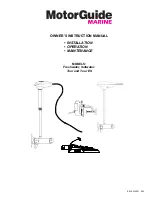
ZIO, Motherboard User Manual
Rev. 2.0
Zilogic Systems
Page 17
Reverse
The current flows in the opposite direction through the motor.
Brake
Applying same voltage to both the terminals, counters the back EMF produced
by the motor, and causes it to come to a sudden stop.
Free-run
Power is cut-off from the motor, and the motor free-runs and eventually stops.
To control the motor through digital signals, the switches are replaced by transistors / MOSFETs.
Driver ICs like the L298, that implement the H-Bridge can also be used for motor control
applications. The block diagram of one half of a L298 is shown in the following diagram.
By controlling the inputs, various functions can be selected, as shown in the table below.
In1
In2
Function
0
0
Brake
0
1
Reverse
1
0
Forward
1
1
Brake
When in Forward state or Reverse state, the speed of the motor can be controlled by driving the
inputs with a PWM signal
In1 (Duty Cycle)
In2 (Duty Cycle)
Function
0%
0%
Brake
100%
100%
Brake
0%
100%
Reverse, full speed
100%
0%
Forward, full speed
0%
X%
Reverse, speed proportional to duty cycle
X%
0%
Forward, speed proportional to duty cycle
A circuit for interfacing a DC motor to the PWM port using the L298, is shown in the following
diagram.






































